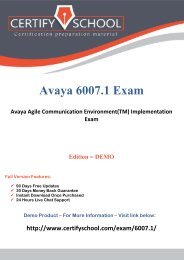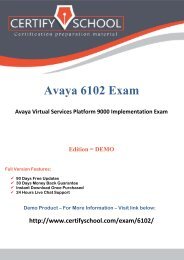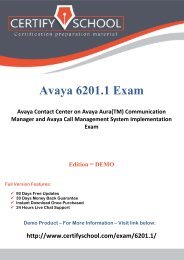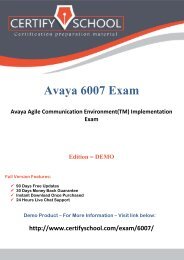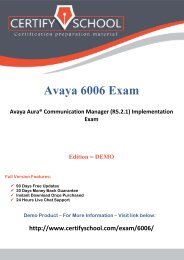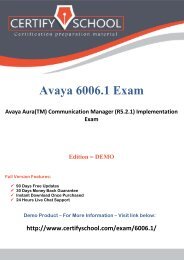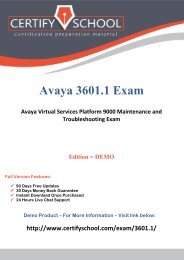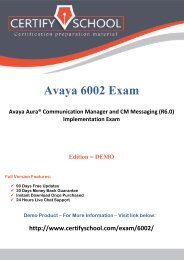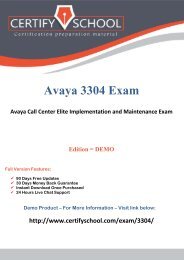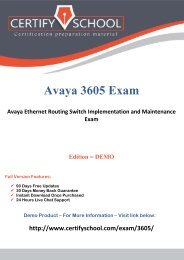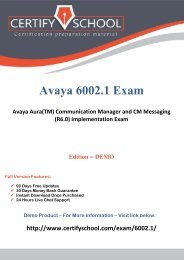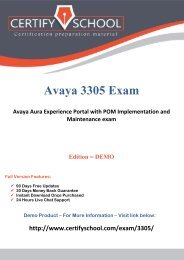70-417 Exam
For more Full product Details:www.CertifySchool.com Our workable study material for exam meets the exact and accurate exam questions and answers. So that’s why CertifySchool is popular in the field of IT Certification Exams material providers.Please visit site: www.CertifySchool.com/
For more Full product Details:www.CertifySchool.com
Our workable study material for exam meets the exact and accurate exam questions and answers. So that’s why CertifySchool is popular in the field of IT Certification Exams material providers.Please visit site: www.CertifySchool.com/
You also want an ePaper? Increase the reach of your titles
YUMPU automatically turns print PDFs into web optimized ePapers that Google loves.
www.CertifySchool.com Certification Preparation Material (PDF)<br />
Microsoft <strong>70</strong>-<strong>417</strong> <strong>Exam</strong><br />
Microsoft Upgrading Your Skills to MCSA Windows Server 2012<br />
Edition = DEMO<br />
Full Version Features:<br />
90 Days Free Updates<br />
30 Days Money Back Guarantee<br />
Instant Download Once Purchased<br />
24 Hours Live Chat Support<br />
Demo Product – For More Information – Visit link below:<br />
http://www.certifyschool.com/exam/<strong>70</strong>-<strong>417</strong>/<br />
http://www.certifyschool.com/exam/<strong>70</strong>-<strong>417</strong>/<br />
Page | 1
www.CertifySchool.com Certification Preparation Material (PDF)<br />
Question: 1<br />
Your network contains an Active Directory domain named contoso.com. The domain contains a server named<br />
Server1. Server1 runs Windows Server 2012 R2 and has the Hyper-V server role installed.<br />
On Server1, you create and start a virtual machine named VM1. VM1 is configured as shown in the following table.<br />
You plan to create a checkpoint of VM1.<br />
You need to recommend a solution to minimize the amount of disk space used for the checkpoint of VM1.<br />
What should you do before you create the checkpoint<br />
A. Decrease the Maximum RAM.<br />
B. Convert diskl.vhd to a dynamically expanding disk.<br />
C. Run the Stop-VM cmdlet.<br />
D. Run the Resize-VHD cmdlet.<br />
Question: 2<br />
Answer: A<br />
Your network contains a server named Server1 that runs Windows Server 2012. Server1 has the Hyper-V server role<br />
installed.<br />
Server1 hosts four virtual machines named VM1, VM2, VM3, and VM4.<br />
Server1 is configured as shown in the following table.<br />
You install a network monitoring application on VM2.<br />
You need to ensure that all of the traffic sent to VM3 can be captured on VM2.<br />
What should you configure<br />
A. NUMA topology<br />
B. Resource control<br />
C. Resource metering<br />
D. Virtual Machine Chimney<br />
E. The VLAN ID<br />
F. Processor Compatibility<br />
G. The startup order<br />
http://www.certifyschool.com/exam/<strong>70</strong>-<strong>417</strong>/<br />
Page | 2
www.CertifySchool.com Certification Preparation Material (PDF)<br />
H. Automatic Start Action<br />
I. Integration Services<br />
J. Port mirroring<br />
K. Single-root I/O virtualization<br />
Answer: J<br />
Explanation:<br />
With Hyper-V Virtual Switch port mirroring, you can select the switch ports that are monitored as well as the switch<br />
port that receives copies of all the traffic. And since Port mirroring allows the network traffic of a virtual machine to<br />
be monitored by copying the traffic and forwarding it to another virtual machine that is configured for monitoring,<br />
you should configure port mirroring on VM2.<br />
Incorrect answers:<br />
A: NUMA spanning is a processor setting that works by projecting a virtual NUMA topology to the guest operating<br />
system in a way that is optimized to match the NUMA topology of the underlying physical host machine. The effect is<br />
to provide virtual machines with additional computing resources for high-performance server applications such as<br />
Microsoft SQL Server and modern server operating systems such as Windows Server 2012 that include built-in NUMA<br />
optimizations.<br />
B: Resource control in used in the event where you need to adjust the computing resources of a virtual machine, you<br />
can reconfigure the resources to meet the changing needs. You can also specify resource controls to automate how<br />
resources are allocated to virtual machines.<br />
C: Resource metering includes:<br />
• Total incoming network traffic, measured in megabytes, for a virtual network adapter.<br />
• Total outgoing network traffic, measured in megabytes, for a virtual network adapter<br />
In other words not capturing, just measuring traffic over the network adapters.<br />
D: Virtual Machine Chimney or TCP Chimney Offload as it is also known, transfers Transmission Control Protocol<br />
(TCP) traffic processing, such as packet segmentation and reassembly processing tasks, from a computer’s CPU to a<br />
network adapter that supports TCP Chimney Offload. Moving TCP/IP processing from the CPU to the network<br />
adapter can free the CPU to perform more application-level functions. TCP Chimney Offload can offload the<br />
processing for both TCP/IPv4 and TCP/IPv6 connections if supported by the network adapter.<br />
E: VLAN ID is used to specify a segment of the VLAN or isolate network traffic for the virtual network adapter.<br />
F: Processor settings is used to configure the number of virtual processors that the virtual machine uses, enable<br />
processor compatibility to allow live migrations to hosts having a different processor architecture, or configure the<br />
NUMA topology on a NUMA-capable host, not to monitor network traffic.<br />
G: The Startup order is set in the BIOS of the computer and has no effect on network monitoring.<br />
H: Automatic start action allows you to specify what the virtual machine should do when the host machine boots up.<br />
The options you can choose from are to automatically start the virtual machine if it was running when the VMM<br />
service on the host stopped (the default), to always start the virtual machine automatically, or to do nothing. You can<br />
also specify a startup delay in seconds to reduce resource content between different virtual machines starting up on<br />
the host.<br />
I: Integration Services settings on virtual machines include services such as operating system shutdown, time<br />
synchronization, data exchange, Heartbeat, and Backup (volume snapshot services not network monitoring.<br />
K: Single-root I/O virtualization -capable network adapters can be assigned directly to a virtual machine to maximize<br />
network throughput while minimizing network latency and the CPU overhead required for processing network<br />
traffic.<br />
References:<br />
http://technet.microsoft.com/en-us/library/jj679878.aspx#bkmk_portmirror<br />
Question: 3<br />
Your network contains a server named Server1 that runs Windows Server 2012. Server1 has the Hyper-V server role<br />
installed.<br />
Server1 hosts four virtual machines named VM1, VM2, VM3, and VM4.<br />
Server1 is configured as shown in the following table.<br />
http://www.certifyschool.com/exam/<strong>70</strong>-<strong>417</strong>/<br />
Page | 3
www.CertifySchool.com Certification Preparation Material (PDF)<br />
You plan to schedule a complete backup of Served by using Windows Server Backup.<br />
You need to ensure that the state of VM1 is saved before the backup starts.<br />
What should you configure<br />
A. NUMA topology<br />
B. Resource control<br />
C. Resource metering<br />
D. Virtual Machine Chimney<br />
E. The VLAN ID<br />
F. Processor Compatibility<br />
G. The startup order<br />
H. Automatic Start Action<br />
I. Integration Services<br />
J. Port mirroring<br />
K. Single-root I/O virtualization<br />
http://www.certifyschool.com/exam/<strong>70</strong>-<strong>417</strong>/<br />
Answer: I<br />
Explanation:<br />
The Integration Services settings on virtual machines include services such as operating system shutdown, time<br />
synchronization, data exchange, Heartbeat, and Backup (volume snapshot services). This snapshot will ensure that<br />
the state of VM1 is saved prior to backup.<br />
Incorrect answers:<br />
A: NUMA spanning is a processor setting that works by projecting a virtual NUMA topology to the guest operating<br />
system in a way that is optimized to match the NUMA topology of the underlying physical host machine. The effect is<br />
to provide virtual machines with additional computing resources for high-performance server applications such as<br />
Microsoft SQL Server and modern server operating systems such as Windows Server 2012 that include built-in NUMA<br />
optimizations.<br />
B: Resource control in used in the event where you need to adjust the computing resources of a virtual machine, you<br />
can reconfigure the resources to meet the changing needs. You can also specify resource controls to automate how<br />
resources are allocated to virtual machines.<br />
C: Resource metering includes:<br />
• Average CPU usage, measured in megahertz over a period of time.<br />
• Average physical memory usage, measured in megabytes.<br />
• Minimum memory usage (lowest amount of physical memory).<br />
• Maximum memory usage (highest amount of physical memory).<br />
• Maximum amount of disk space allocated to a virtual machine.<br />
• Total incoming network traffic, measured in megabytes, for a virtual network adapter.<br />
• Total outgoing network traffic, measured in megabytes, for a virtual network adapter<br />
D: Virtual Machine Chimney or TCP Chimney Offload as it is also known, transfers Transmission Control Protocol<br />
(TCP) traffic processing, such as packet segmentation and reassembly processing tasks, from a computer’s CPU to a<br />
network adapter that supports TCP Chimney Offload. Moving TCP/IP processing from the CPU to the network<br />
adapter can free the CPU to perform more application-level functions. TCP Chimney Offload can offload the<br />
processing for both TCP/IPv4 and TCP/IPv6 connections if supported by the network adapter.<br />
Page | 4
www.CertifySchool.com Certification Preparation Material (PDF)<br />
E: VLAN ID is used to specify a segment of the VLAN or isolate network traffic for the virtual network adapter.<br />
F: Processor settings is used to configure the number of virtual processors that the virtual machine uses, enable<br />
processor compatibility to allow live migrations to hosts having a different processor architecture, or configure the<br />
NUMA topology on a NUMA-capable host.<br />
G: The startup order is set in the BIOS of the computer. It has nothing to do with backups.<br />
H: Automatic start action allows you to specify what the virtual machine should do when the host machine boots up.<br />
The options you can choose from are to automatically start the virtual machine if it was running when the VMM<br />
service on the host stopped (the default), to always start the virtual machine automatically, or to do nothing. You can<br />
also specify a startup delay in seconds to reduce resource content between different virtual machines starting up on<br />
the host.<br />
J: With Hyper-V Virtual Switch port mirroring you can monitor network traffic not configure backups.<br />
K: Single-root I/O virtualization -capable network adapters can be assigned directly to a virtual machine to maximize<br />
network throughput while minimizing network latency and the CPU overhead required for processing network<br />
traffic.<br />
References:<br />
http://msdn.microsoft.com/en-us/library/dd405549(v=vs.85).aspx<br />
<strong>Exam</strong> Ref <strong>70</strong>-410, Installing and Configuring Windows Server 2012, Chapter 3: Configure Hyper-V, Objective 3.1:<br />
Create and Configure virtual machine settings, p. 144<br />
Question: 4<br />
Your network contains a server named Server1 that runs Windows Server 2012. Server1 has the Hyper-V server role<br />
installed.<br />
Server1 hosts four virtual machines named VM1, VM2, VM3, and VM4.<br />
Server1 is configured as shown in the following table.<br />
VM3 is used to test applications.<br />
You need to prevent VM3 from synchronizing its clock to Server1.<br />
What should you configure<br />
A. NUMA topology<br />
B. Resource control<br />
C. Resource metering<br />
D. Virtual Machine Chimney<br />
E. The VLAN ID<br />
F. Processor Compatibility<br />
G. The startup order<br />
H. Automatic Start Action<br />
I. Integration Services<br />
J. Port mirroring<br />
K. Single-root I/O virtualization<br />
Answer: I<br />
http://www.certifyschool.com/exam/<strong>70</strong>-<strong>417</strong>/<br />
Page | 5
www.CertifySchool.com Certification Preparation Material (PDF)<br />
Explanation:<br />
Integration Services settings on virtual machines includes services such as operating system shutdown, time<br />
synchronization, data exchange, Heart beat, and Backup (volume snapshot services. Thus you should disable the time<br />
synchronization using Integration Services.<br />
Incorrect answers:<br />
A: NUMA spanning is a processor setting that works by projecting a virtual NUMA topology to the guest operating<br />
system in a way that is optimized to match the NUMA topology of the underlying physical host machine. The effect is<br />
to provide virtual machines with additional computing resources for high-performance server applications such as<br />
Microsoft SQL Server and modern server operating systems such as Windows Server 2012 that include built-in NUMA<br />
optimizations.<br />
B: Resource control in used in the event where you need to adjust the computing resources of a virtual machine, you<br />
can reconfigure the resources to meet the changing needs. You can also specify resource controls to automate how<br />
resources are allocated to virtual machines.<br />
C: Resource metering includes:<br />
• Average CPU usage, measured in megahertz over a period of time.<br />
• Average physical memory usage, measured in megabytes.<br />
• Minimum memory usage (lowest amount of physical memory).<br />
• Maximum memory usage (highest amount of physical memory).<br />
• Maximum amount of disk space allocated to a virtual machine.<br />
• Total incoming network traffic, measured in megabytes, for a virtual network adapter.<br />
• Total outgoing network traffic, measured in megabytes, for a virtual network adapter<br />
D: Virtual Machine Chimney or TCP Chimney Offload as it is also known, transfers Transmission Control Protocol<br />
(TCP) traffic processing, such as packet segmentation and reassembly processing tasks, from a computer’s CPU to a<br />
network adapter that supports TCP Chimney Offload. Moving TCP/IP processing from the CPU to the network<br />
adapter can free the CPU to perform more application-level functions. TCP Chimney Offload can offload the<br />
processing for both TCP/IPv4 and TCP/IPv6 connections if supported by the network adapter.<br />
E: VLAN ID is used to specify a segment of the VLAN or isolate network traffic for the virtual network adapter.<br />
F: Processor settings is used to configure the number of virtual processors that the virtual machine uses, enable<br />
processor compatibility to allow live migrations to hosts having a different processor architecture, or configure the<br />
NUMA topology on a NUMA-capable host.<br />
G: The startup order is set in the BIOS of the computer, the question wants you do prevent time synchronization<br />
instead.<br />
H: Automatic start action allows you to specify what the virtual machine should do when the host machine boots up.<br />
The options you can choose from are to automatically start the virtual machine if it was running when the VMM<br />
service on the host stopped (the default), to always start the virtual machine automatically, or to do nothing. You can<br />
also specify a startup delay in seconds to reduce resource content between different virtual machines starting up on<br />
the host.<br />
J: With Hyper-V Virtual Switch port mirroring you can monitor network traffic not prevent time synchronization.<br />
K: Single-root I/O virtualization -capable network adapters can be assigned directly to a virtual machine to maximize<br />
network throughput while minimizing network latency and the CPU overhead required for processing network<br />
traffic.<br />
References:<br />
http://blogs.technet.com/b/virtualization/archive/2008/08/29/backing-up-hyper-v-virtual-machines.aspx<br />
<strong>Exam</strong> Ref <strong>70</strong>-410, Installing and Configuring Windows Server 2012, Chapter 3: Configure Hyper-V, Objective 3.1:<br />
Create and Configure virtual machine settings, p. 144<br />
Question: 5<br />
Your network contains a server named Server1 that runs Windows Server 2012. Server1 has the Hyper-V server role<br />
installed.<br />
Server1 hosts four virtual machines named VM1, VM2, VM3, and VM4.<br />
Server1 is configured as shown in the following table.<br />
http://www.certifyschool.com/exam/<strong>70</strong>-<strong>417</strong>/<br />
Page | 6
www.CertifySchool.com Certification Preparation Material (PDF)<br />
VM2 sends and receives large amounts of data over the network.<br />
You need to ensure that the network traffic of VM2 bypasses the virtual switches of the parent partition.<br />
What should you configure<br />
A. NUMA topology<br />
B. Resource control<br />
C. Resource metering<br />
D. Virtual Machine Chimney<br />
E. The VLAN ID<br />
F. Processor Compatibility<br />
G. The startup order<br />
H. Automatic Start Action<br />
I. Integration Services<br />
J. Port mirroring<br />
K. Single-root I/O virtualization<br />
http://www.certifyschool.com/exam/<strong>70</strong>-<strong>417</strong>/<br />
Answer: K<br />
Explanation:<br />
Single-root I/O virtualization -capable network adapters can be assigned directly to a virtual machine to maximize<br />
network throughput while minimizing network latency and the CPU overhead required for processing network<br />
traffic.<br />
Incorrect answers:<br />
A: NUMA spanning is a processor setting that works by projecting a virtual NUMA topology to the guest operating<br />
system in a way that is optimized to match the NUMA topology of the underlying physical host machine. The effect is<br />
to provide virtual machines with additional computing resources for high-performance server applications such as<br />
Microsoft SQL Server and modern server operating systems such as Windows Server 2012 that include built-in NUMA<br />
optimizations.<br />
B: Resource control in used in the event where you need to adjust the computing resources of a virtual machine, you<br />
can reconfigure the resources to meet the changing needs. You can also specify resource controls to automate how<br />
resources are allocated to virtual machines.<br />
C: Resource metering includes:<br />
• Average CPU usage, measured in megahertz over a period of time.<br />
• Average physical memory usage, measured in megabytes.<br />
• Minimum memory usage (lowest amount of physical memory).<br />
• Maximum memory usage (highest amount of physical memory).<br />
• Maximum amount of disk space allocated to a virtual machine.<br />
• Total incoming network traffic, measured in megabytes, for a virtual network adapter.<br />
• Total outgoing network traffic, measured in megabytes, for a virtual network adapter<br />
• D: Virtual Machine Chimney or TCP Chimney Offload as it is also known, transfers Transmission Control Protocol<br />
(TCP) traffic processing, such as packet segmentation and reassembly processing tasks, from a computer’s CPU to a<br />
network adapter that supports TCP Chimney Offload. Moving TCP/IP processing from the CPU to the network<br />
adapter can free the CPU to perform more application-level functions. TCP Chimney Offload can offload the<br />
processing for both TCP/IPv4 and TCP/IPv6 connections if supported by the network adapter.<br />
Page | 7
www.CertifySchool.com Certification Preparation Material (PDF)<br />
E: VLAN ID is used to specify a segment of the VLAN or isolate network traffic for the virtual network adapter.<br />
F: Processor settings is used to configure the number of virtual processors that the virtual machine uses, enable<br />
processor compatibility to allow live migrations to hosts having a different processor architecture, or configure the<br />
NUMA topology on a NUMA-capable host.<br />
G. Configure the BIOS of the computer to enable PXE boot, and set the boot order so that it is booting from the<br />
network is first.<br />
H: Automatic start action allows you to specify what the virtual machine should do when the host machine boots up.<br />
The options you can choose from are to automatically start the virtual machine if it was running when the VMM<br />
service on the host stopped (the default), to always start the virtual machine automatically, or to do nothing. You can<br />
also specify a startup delay in seconds to reduce resource content between different virtual machines starting up on<br />
the host.<br />
I: Integration Services settings on virtual machines include services such as operating system shutdown, time<br />
synchronization, data exchange, Heartbeat, and Backup (volume snapshot services.<br />
J: With Hyper-V Virtual Switch port mirroring you can monitor network traffic not modify the startup order.<br />
References:<br />
http://technet.microsoft.com/en-us/library/cc766320(v=ws.10).aspx<br />
http://technet.microsoft.com/en-us/library/hh831410.aspx<br />
<strong>Exam</strong> Ref <strong>70</strong>-410, Installing and Configuring Windows Server 2012, Chapter 3: Configure Hyper-V, Objective 3.1:<br />
Create and Configure virtual machine settings, p. 144<br />
Training Guide: Installing and Configuring Windows Server 2012: Chapter 7: Hyper-V Virtualization, Lesson 2:<br />
Deploying and configuring virtual machines, p. 335<br />
Question: 6<br />
You perform a Server Core Installation of Windows Server 2012 R2 on a server named Server1.<br />
You need to add a graphical user interface (GUI) to Server1.<br />
Which tool should you use<br />
A. The imagex.exe command<br />
B. The ocsetup.exe command<br />
C. The setup.exe command<br />
D. The dism.exe command<br />
Question: 7<br />
Answer: D<br />
You have a server named Server1 that runs Windows Server 2012 R2.<br />
You plan to create an image of Server1.<br />
You need to remove the source files for all server roles that are not installed on Server1.<br />
Which tool should you use<br />
A. dism.exe<br />
B. servermanagercmd.exe<br />
C. ocsetup.exe<br />
D. imagex.exe<br />
Answer: A<br />
Explanation:<br />
The Dism utility can be used to create and mount an image of Server1.<br />
Incorrect answers:<br />
http://www.certifyschool.com/exam/<strong>70</strong>-<strong>417</strong>/<br />
Page | 8
www.CertifySchool.com Certification Preparation Material (PDF)<br />
A: This is the wrong tool.<br />
B. The imagex.exe command is used to create windows and to apply image to drive.<br />
D: The ocsetup command will execute a setup.<br />
References:<br />
http://technet.microsoft.com/en-us/library/cc749447(v=ws.10).aspx<br />
http://technet.microsoft.com/en-us/library/dd744382(v=ws.10).aspx<br />
Training Guide: Installing and Configuring Windows Server 2012: Chapter 2: Deploying Servers, p. 44<br />
<strong>Exam</strong> Ref <strong>70</strong>-410: Installing and Configuring Windows Server 2012: Chapter 1: Installing and Configuring Servers, p.<br />
19-22<br />
Question: 8<br />
You have a server named Server1 that runs Windows Server 2012 R2. Server1 has following storage spaces:<br />
• Data<br />
• Users<br />
• Backups<br />
• Primordial<br />
You add an additional hard disk to Server1.<br />
You need to identify which storage space contains the new hard disk.<br />
Which storage space contains the new disk<br />
A. Primordial<br />
B. Data<br />
C. Backups<br />
D. Users<br />
Answer: A<br />
Explanation:<br />
New Disks (Unallocated space) added to Primordial space.<br />
Incorrect answers:<br />
A: It cannot be in the Data storage space as it is a new disk that has just been added.<br />
C: It is a new disk that had been added and will thus not be found under the Users storage space.<br />
D: This is a new disk that has just been added, it does not contain Backups and will thus not be in this storage space<br />
since it is not in the primordial storage space.<br />
References:<br />
http://blogs.technet.com/b/canitpro/archive/2012/12/13/storage-pools-dive-right-in.aspx<br />
Question: 9<br />
Your network contains an Active Directory domain named contoso.com. The domain contains a server named<br />
Server1. Server1 runs Windows Server 2012.<br />
You create a group Managed Service Account named gservice1.<br />
You need to configure a service named Service1 to run as the gservice1 account.<br />
How should you configure Service1<br />
A. From a command prompt, run sc.exe and specify the config parameter.<br />
B. From a command prompt, run sc.exe and specify the sdset parameter.<br />
C. From the Services console, configure the General settings.<br />
D. From Windows PowerShell, run Set-Service and specify the -PassThrough parameter.<br />
http://www.certifyschool.com/exam/<strong>70</strong>-<strong>417</strong>/<br />
Answer: A<br />
Page | 9
www.CertifySchool.com Certification Preparation Material (PDF)<br />
Explanation:<br />
Executing the sc.exe command with the config parameter will modify service configuration.<br />
Incorrect answers:<br />
A. the General settings tab only allow you to stop, start and set type/parameters.<br />
B. Set-Service provides a way for you to change the Description, StartupType, or DisplayName of a service.<br />
D. Sets the response/action on service failure.<br />
References:<br />
http://windows.microsoft.com/en-us/windows-vista/using-system-configuration<br />
http://technet.microsoft.com/en-us/library/ee176963.aspx<br />
http://technet.microsoft.com/en-us/library/cc990290(v=ws.10).aspx<br />
http://technet.microsoft.com/en-us/library/cc738230(v=ws.10).aspx<br />
Question: 10<br />
You have a server named Data1 that runs a Server Core Installation of Windows Server 2012 R2 Standard.<br />
You need to configure Dat 1 to run a Server Core Installation of Windows Server 2012 R2 Datacenter. You want to<br />
achieve this goal by using the minimum amount of administrative effort.<br />
What should you perform<br />
A. An online servicing by using Dism<br />
B. An offline servicing by using Dism<br />
C. An upgrade installation of Windows Server 2012 R2<br />
D. A clean installation of Windows Server 2012 R2<br />
Answer: A<br />
Explanation:<br />
There are a couple of ways to install the GUI from the command prompt, although both use the same tool – DISM<br />
(Deployment Image Service Manager). When you are doing it for a single (local) server, the command is:<br />
Dism /online /enable-feature /featurename:ServerCore-FullServer /featurename:…<br />
Incorrect answers:<br />
A: This option involves too much administrative effort whereas you could just use a DISM command once.<br />
B: This should work, but not with the east amount of administrative effort.<br />
D: The DISM utility needs to be used online, not offline.<br />
References:<br />
Training Guide: Installing and Configuring Windows Server 2012: Chapter 2: Deploying Servers, p. 44<br />
<strong>Exam</strong> Ref <strong>70</strong>-410: Installing and Configuring Windows Server 2012: Chapter 1: Installing and Configuring Servers, p.<br />
19-22<br />
Question: 11<br />
Your network contains an Active Directory forest named contoso.com.<br />
The forest contains two domains named contoso.com and child.contoso.com and two sites named Site1 and Site2.<br />
The domains and the sites are configured as shown in following table.<br />
http://www.certifyschool.com/exam/<strong>70</strong>-<strong>417</strong>/<br />
Page | 10
www.CertifySchool.com Certification Preparation Material (PDF)<br />
When the link between Site1 and Site2 fails, users fail to log on to Site2.<br />
You need to identify what prevents the users in Site2 from logging on to the child.contoso.com domain.<br />
What should you identify<br />
A. The placement of the infrastructure master<br />
B. The placement of the global catalog server<br />
C. The placement of the domain naming master<br />
D. The placement of the PDC emulator<br />
Answer: D<br />
Explanation:<br />
The exhibit shows that Site2 does not have a PDC emulator. This is important because of the close interaction<br />
between the RID operations master role and the PDC emulator role<br />
The PDC emulator processes password changes from earlier-version clients and other domain controllers on a besteffort<br />
basis; handles password authentication requests involving passwords that have recently changed and not yet<br />
been replicated throughout the domain; and, by default, synchronizes time. If this domain controller cannot connect<br />
to the PDC emulator, this domain controller cannot process authentication requests, it may not be able to<br />
synchronize time, and password updates cannot be replicated to it.<br />
Incorrect answers:<br />
A: The global catalogue server role placement is not the issue.<br />
C: The PDC emulator role, not the infrastructure master role will process authentication requests that will allow<br />
logging on for the Site2 users.<br />
D: The domain naming master role is not the role that prevents Site2 users from logging on to the child domain.<br />
References:<br />
http://technet.microsoft.com/en-us/library/dd3918<strong>70</strong>(v=ws.10).aspx<br />
http://technet.microsoft.com/en-us/library/cc773108(v=ws.10).aspx<br />
Question: 12<br />
Your network contains an Active Directory forest that contains two domains. The forest contains five domain<br />
controllers.<br />
The domain controllers are configured as shown in the following table.<br />
http://www.certifyschool.com/exam/<strong>70</strong>-<strong>417</strong>/<br />
Page | 11
www.CertifySchool.com Certification Preparation Material (PDF)<br />
You need to configure DC5 as a global catalog server.<br />
Which tool should you use<br />
A. Active Directory Administrative Center<br />
B. Active Directory Users and Computers<br />
C. Active Directory Sites and Services<br />
D. Active Directory Domains and Trusts<br />
Answer: C<br />
Explanation:<br />
Active Directory Sites and Services can be used to Add or remove the global catalog read-only directory partitions<br />
from a domain controller in the site. Confirm that all read-only directory partitions have been replicated to the new<br />
global catalog server. As well as verify that the global catalog server is being advertised in Domain Name System<br />
(DNS).<br />
References:<br />
http://technet.microsoft.com/en-us/library/cc730868.aspx<br />
http://technet.microsoft.com/en-us/library/cc7<strong>70</strong>674.aspx<br />
Question: 13<br />
Your network contains an Active Directory forest. The forest contains a single domain named contoso.com. The<br />
domain contains four domain controllers.<br />
The domain controllers are configured as shown in the following table.<br />
All domain controllers are DNS servers.<br />
You plan to deploy a new domain controller named DC5 in the contoso.com domain.<br />
You need to identify which domain controller must be online to ensure that DC5 can be promoted successfully to a<br />
domain controller.<br />
Which domain controller should you identify<br />
A. DC1<br />
B. DC2<br />
C. DC3<br />
D. DC4<br />
http://www.certifyschool.com/exam/<strong>70</strong>-<strong>417</strong>/<br />
Page | 12
www.CertifySchool.com Certification Preparation Material (PDF)<br />
Answer: C<br />
Explanation:<br />
To perform a domain controller promotion you need the Infrastructure master to be online.<br />
The schema master and the domain naming master are per-forest roles. Therefore, there is only one schema master<br />
and one domain naming master per forest.<br />
The RID master, the PDC master, and the infrastructure master are per-domain roles. Each domain has its own RID<br />
master, PDC master, and infrastructure master. Therefore, if a forest has three domains, there are three RID masters,<br />
three PDC masters, and three infrastructures masters.<br />
Incorrect answers:<br />
A: The domain naming master Flexible Single Master Operations (FSMO) role holder is assigned to the domain<br />
controller that is responsible for making changes to the CN=Partitions,CN=Configuration, DC=domain configuration<br />
container in Active Directory<br />
B: Active Directory Users and Computers Snap-in will always contact the PDC when User Properties is opened<br />
D: very Exchange Server 5.5 site or Exchange 2000 Server Routing Group needs a Routing Information Daemon (RID)<br />
master, or routing master. This RID master generates the routing table for the rest of the site (or Routing Group),<br />
which replicates to the entire Exchange Server organization. By default the RID master is the first Exchange Server<br />
computer in the site.<br />
References:<br />
http://support.microsoft.com/kb/234790<br />
http://support.microsoft.com/kb/254809<br />
Question: 14<br />
Your network contains an Active Directory forest named contoso.com. All domain controllers currently run Windows<br />
Server 2008 R2.<br />
You plan to install a new domain controller named DC4 that runs Windows Server 2012 R2.<br />
The new domain controller will have the following configurations:<br />
• Schema master<br />
• Global catalog server<br />
• DNS Server server role<br />
• Active Directory Certificate Services server role<br />
You need to identify which configurations cannot be fulfilled by using the Active Directory Domain Services<br />
Configuration Wizard.<br />
Which two configurations should you identify (Each correct answer presents part of the solution. Choose two.)<br />
A. Enable the global catalog server.<br />
B. Transfer the schema master.<br />
C. Install the Active Directory Certificate Services role.<br />
D. Install the DNS Server role.<br />
Answer: B, C<br />
Explanation:<br />
AD Installation Wizard will automatically install DNS and allows for the option to set it as a global catalog server.<br />
ADCS and schema must be done separately.<br />
Incorrect answers:<br />
A: The Global Catalogue server is automatically installed.<br />
C: The DNS server role is automatically installed.<br />
References:<br />
http://technet.microsoft.com/en-us/library/hh831457.aspx<br />
<strong>Exam</strong> Ref <strong>70</strong>-410: Installing and Configuring Windows Server 2012, Chapter 5: Install and administer Active Directory,<br />
Objective 5.1: Install domain controllers, p. 262<br />
http://www.certifyschool.com/exam/<strong>70</strong>-<strong>417</strong>/<br />
Page | 13
www.CertifySchool.com Certification Preparation Material (PDF)<br />
Question: 15<br />
You have a server named Server1 that runs Windows Server 2012.<br />
You promote Server1 to a domain controller.<br />
You need to view the service location (SRV) records that Server1 registers in DNS.<br />
What should you do on Server1<br />
A. Open the Netlogon.dns file.<br />
B. Run ipconfig /displaydns.<br />
C. Run Get-DnsServerDiagnostics.<br />
D. Open the Srv.sys file.<br />
Answer: A<br />
Explanation:<br />
Netlogon.dns - If you are using non-Microsoft DNS servers to support Active Directory, you can verify SRV locator<br />
resource records by viewing Netlogon.dns. Netlogon.dns is located in the %systemroot%\System32\Config folder.<br />
You can use a text editor, such as Microsoft Notepad, to view this file.<br />
The first record in the file is the domain controller's Lightweight Directory Access Protocol (LDAP) SRV record.<br />
Incorrect answers:<br />
A: Server1 has been promoted to a domain controller and if you want to view the SRV records then you should open<br />
the NetLogon.dns files.<br />
C: Server1’s SRV records can only be viewed via the NetLogon.dns file.<br />
D: The Server1 SRV records should be viewed via the NetLogon.dns file.<br />
References:<br />
http://support.microsoft.com/kb/816587/en-us<br />
http://www.certifyschool.com/exam/<strong>70</strong>-<strong>417</strong>/<br />
Page | 14
www.CertifySchool.com Certification Preparation Material (PDF)<br />
Demo Product – For More Information – Visit link below:<br />
http://www.certifyschool.com/exam/<strong>70</strong>-<strong>417</strong>/<br />
Thanks for Using Our Product<br />
http://www.certifyschool.com/exam/<strong>70</strong>-<strong>417</strong>/<br />
Page | 15




